- What grows in the garden?
- Ingredients and medicinal properties of peppermint
- Contraindications to the use of peppermint
- Scope of mint
- Application of mint in folk medicine - popular recipes
- Beauty recipes
- Peppermint during pregnancy
The medicinal properties and contraindications of peppermint are known for a long time. Even the ancient Roman philosophers and thinkers spoke of it as a grass, clarifying the mind and giving health. In ancient Russia, fragrant bundles were hung in the hut to ward off evil spirits. And in the countries of Asia, mint was paid for services and goods.
The plant is also valued in our time. Where only do not use fragrant grass - in cooking and cosmetology, medicine and perfumery. But peppermint is especially popular among folk healers. From it prepare teas, decoctions and infusions, use for masks and rinsing hair. What is so good about this, inconspicuous at first glance, grass?
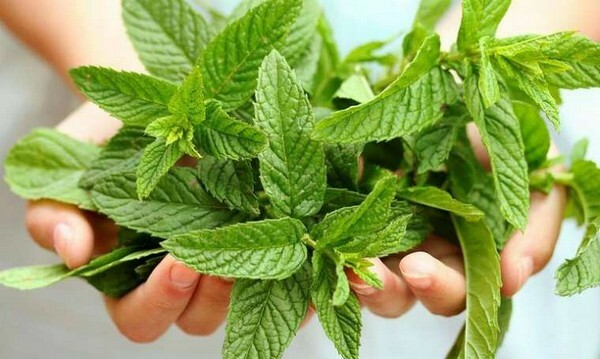
What grows in the garden?
There is not one dozen varieties of mint, but the most famous and popular in our country is peppery. It is her inexperienced gardeners who are often confused with melissa. Indeed, these herbs are very similar in appearance, but have some differences in chemical composition.
Mint flavor is bright and saturated, with a pronounced hint of menthol. This is explained by the high concentration of essential oils in the leaves and flowers of the plant. Melissa smells softer and resembles the aroma of lemon. No wonder it is called "lemon grass" or "lemon mint".Esters in melissa are much less - no more than 1%.
What is more useful, mint or melissa? Unequivocally, this question can not be answered. Each herb is good in its own way, but on the human body they act almost identically. However, despite the high medicinal properties of lemon balm, non-traditional medicine prefers peppermint. Maybe because of its fresh and slightly tart flavor?Composition and medicinal properties of peppermint
According to pharmacognosy( the branch of pharmacy studying raw materials of natural origin), the value of the medicinal plant is due to the high content of menthol oil. In the leaves of mint it is 4-5%, and in the inflorescences - slightly more than 6%.This is a rather high concentration and the better the growth conditions, the more ether is present in the soft parts of the grass.
With local application, menthol oil has an irritating and cooling effect, has a pronounced bactericidal effect, and actively affects the nerve endings.
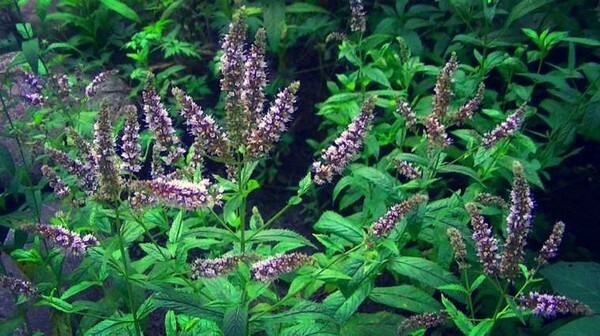
It's interesting. Its name was given to mint in honor of the ancient nymph Minta, which was ruined by the wife of the ruler of the kingdom of the dead Aida. Therefore, in the people it is considered female grass and is widely used to eliminate menstrual cramps.
What is useful for mint? In addition to menthol oil, the medicinal plant contains a whole list of medicinal components:
- vitamins C, B1, B2, B3, B5, B6, carotene;
- organic acids;
- resinous and tannic compounds;
- bitterness;
- Hesperides;
- fiber, fats, proteins and carbohydrates;
- of sugar;
- microelements - iron, calcium, phosphorus, sodium, magnesium, potassium;
- saponins.
Peppermint is used as an anesthetic, anti-inflammatory, vasodilating and soothing. Included in her bitterness improves the work of the digestive tract, restore intestinal motility, stimulate bile secretion. The smell of menthol helps to focus, increases brain activity, activates memory and attention.
Many studies have proven the anti-cancer effect of peppermint. It is effective in the treatment of herpes, pneumonia, tuberculosis. Especially useful for women. Traditional healers recommend it for the removal of symptoms of a climacteric nature, PMS, with various gynecological diseases.
Contraindications to the use of peppermint
Excessive fascination with peppermint medicines may adversely affect your health and overall well-being. Therefore, when starting treatment, it is necessary to remember the limitations:
- varicose veins;
- reduced blood pressure;
- period of breastfeeding( lactation may be reduced);
- individual reaction to plant components.

People have the opinion that mint is contraindicated to strong sex because of its ability to reduce libido. There is no scientific confirmation of such information. Nevertheless, men should heed the advice of traditional healers and not be addicted to phytotherapy. The soothing and relaxing effect of the grass can very well affect the potency.
Warning. Peppermint is not desirable for people employed in hazardous industries or associated with the management of precise machines and mechanisms. It is not recommended for medicinal plants and workers with high emotional stress: dispatchers serving in emergency response groups.
In cases of excess dosage or frequency of peppermint consumption, there may be side effects:
- allergies;
- disorders of the intestines, eructations;
- severity and pain in the digestive tract, heartburn;
In order not to provoke possible unwanted reactions, it is necessary to know when and how to use medicinal herb.
Sphere of application of mint
Useful properties of peppermint have been studied in detail at the end of XVIII century by British scientists. It was in England that a number of experiments were carried out, proving the beneficial effect of plants on the human body. In the course of the studies, the irritant ability of menthol, its effect on constriction and vasodilation, was considered. The effect was used to create Validol, which removes attacks of angina pectoris.

What helps mint? The scope of its use is very wide - these are various diseases and pathological conditions:
- Headaches and tooth pains, bruises, neuralgia.
- Skin lesions - dermatitis, burns, acne, insect bites.
- Dandruff, greasiness of hair.
- Wrinkles, enlarged pores, face ptosis.
- Respiratory infections, influenza, acute respiratory infections and ARVI, rhinitis, pneumonia, tuberculosis.
- Gynecologic ailments, painful and profuse menstruation, climacteric syndrome.
- Liver and liver ailments - spasms, colic, nausea, flatulence, cholecystitis, hepatitis, helminthic invasions.
- Disorders in the work of the cardiovascular system - tachycardia, spasm of the vessels of the heart, angina, elevated blood pressure.
- Nervous irritability, insomnia, emotional overstrain, impaired attention and memory.
Peppermint is quite effective as prevention of cancer, especially in the prostate, lung, colon, breast and skin.
Caution. The medicinal plant increases the immunity and resistance of the organism with prolonged exposure to radiation, therefore it is often used as an additional measure in chemotherapy.
The healing properties of mint made it truly indispensable in many situations. And the plant is used not only in the recipes of traditional medicine.
Pharmaceutical preparations
On the counters of drugstores you can see a lot of medicines made on the basis of fragrant herbs. These are packaged peppermint teas and shredded raw materials in cardboard boxes, essential oils in a concentrated form.
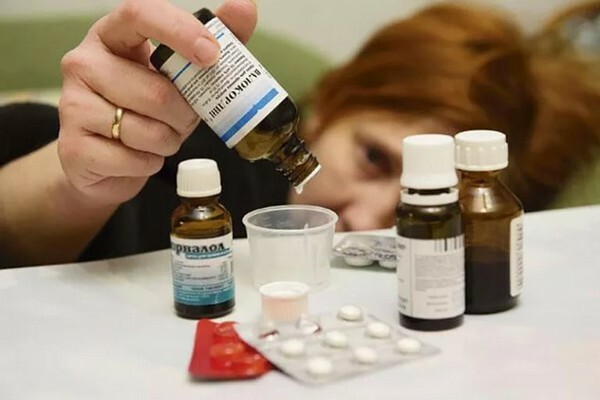
Menthol, isolated from leaves and flowers, is a part of tablets from motion sickness, ointments, crayons from a cold and headache, and also used for making all known medicines - Mark,, Corvalol, Doctor Mom, Ingafen, Menovazine, drops Zelenin and many other medications. Menthol oil is widely used for aromatization of toothpastes, mouth rinses, shampoos, face creams.
Mint application in folk medicine - popular recipes
Useful properties of all the parts of peppermint - leaves, flowers and stems. They are used in dry or fresh form, both inside and outside. From the medicinal herbs prepare infusions, decoctions, teas, make extracts and essential oils. Each of the dosage forms is used according to its indications, has its own peculiarities of reception and limitations.
Mint tea
A therapeutic drink with a refreshing and soothing aroma is used for nervous breakdowns, physical and emotional overstrain, insomnia, irritability and fatigue. Mint tea eliminates spasms and colic in the abdomen, has a choleretic effect, improves appetite. Especially useful is this infusion for respiratory diseases and throat swelling.
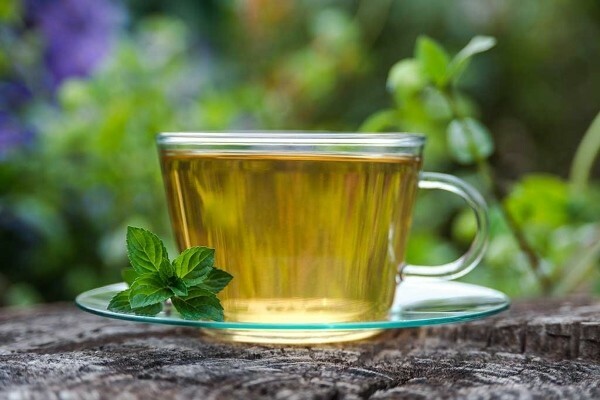
Attention. Patients with hypotension should take tea from mint peppery infrequently and in small amounts.
Prepare the curative infusion as follows:
- a spoonful of dry leaves and flowers( necessarily) pour a glass of boiling water;
- is kept in a sealed container for 15 minutes;
- is filtered and taken in small sips for half an hour before meals.
Brew mint tea and fresh herbs. In this case, the green leaves are lowered into a mug with hot water and allowed to stand for 10 minutes. The same infusion is good rinse your throat and teeth, wash your fat and acne prone skin.
Mint broth
It is better to prepare the preparation from hard parts of a plant that are difficult to part with useful substances - stems, branches, lower leaves. Apply it for wrestling with constipation and high acidity of the stomach, acidic eructation. Assign as an additional remedy for pulmonary hemorrhages.
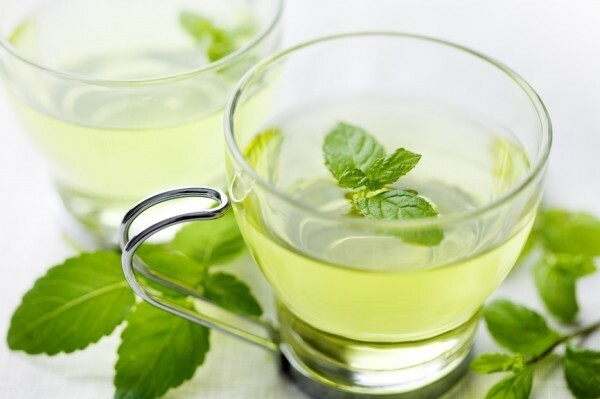
Attention. Decoctions, unlike teas and infusions, are always filtered only by hot ones.
For a mint drink you will need:
- 2 tbsp.l.shredded raw materials;
- 500 ml of water.
The grass is covered in a thermos and poured hot liquid, insist 30 minutes, filter. The broth is taken cold for 2-3 sips before eating.
For sore throat, rhinitis, or adenoiditis, the drug is used for inhalations. Healing couples breathe hot for 10-12 minutes. In the case of skin diseases, calming baths are prescribed based on the water extract from the plant - 70 liters of dry grass are taken per 10 liters of liquid.
Peppermint tincture
Prepare a medicine based on alcohol or vodka. Applied for rinses and inhalations for infectious diseases of the ENT organs, elimination of headaches and migraine headaches.
To create the hood use the following ingredients:
- 50 grams of dry mint;
- 250 ml of alcohol or vodka.
The grass is poured with alcohol and kept in a closed vessel for 25-30 days. Ready tincture is filtered and consumed for 15-25 drops per reception.
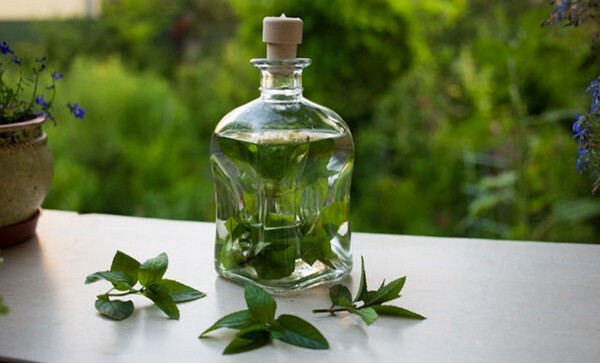
A similar extract is prepared from fresh mint. Rip off the whole bush, crush and pour boiling water, so that only covered parts of the plant. Sugar and 0.75 vodka or alcohol are added to the mixture. Insist in a dark and cool place for at least a month.
Warning. Mint tincture helps with sleep disorders, hiccups, dental and headaches. It improves the functioning of the heart muscle, is used for women's diseases. It is undesirable to use the drug for pregnant women, hypotenics and children.
Essential oil from peppermint
The drug is actively used in diseases of the nervous, digestive and cardiovascular system:
- tachycardia, arrhythmia, angina pectoris;
- hypertension;
- heartburn, belching and nausea, pain in the gastrointestinal tract;
- influenza, angina, laryngitis, pharyngitis, bronchitis, tuberculosis;
- irritability, insomnia, emotional overexertion.
The product has a pronounced analgesic effect, so it is often used for sore throat, caries, gum disease, migraine.
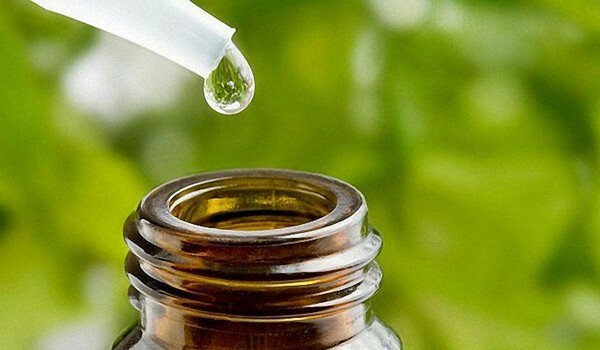
Methods of using menthol oil can be different:
- A little ether is dripped onto a piece of sugar or a spoonful of honey and taken together with tea, juice or lactic acid drinks.
- Inhalation with a nebulizer or a regular pot of hot water is done once a day.
- 7-10 drops of menthol concentrate are added to the soothing baths for the entire volume of the liquid;
- For rinsing in a glass of warm water, dissolve 3-4Caplylester;
- Compresses are prepared from ¼ tsp.means and 25 ml of alcohol or vodka.
Recipes of beauty
Useful properties of peppermint have found wide application in cosmetology and perfumery industry. On its basis, many waste products are produced with a soothing, tonic and cooling effect. Well, since the plant has an aseptic effect and perfectly eliminates unpleasant odors, it is often introduced into deodorants, antiperspirants and mouthwashes.
Skin Care for the face and hands
Peppermint well affects the skin of different types. Sluggish and wrinkled, it tightens, tones and smoothes, greasy - cleans and reduces sebum, fights acne and acne. With regular use of the dermis is saturated with vitamins and trace elements, the complexion improves.
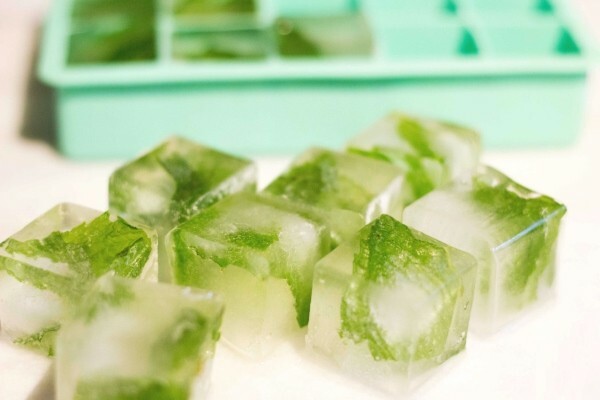
Mint is prepared with lotions and creams, nourishing and moisturizing masks. For example, to combat fatty, acne prone skin preparation of 5 tbsp.l.dry inflorescences and a glass of boiling water. The mixture is insisted, filtered, poured into ice molds and frozen. Every morning the face is wiped with a cold remedy and a suitable cream is applied.
For sagging and wrinkled skin, a mask of crushed fresh leaves, yolks and sour cream is suitable. The ingredients are mixed and applied to the face. Withstand 15-20 minutes and rinse with cool water.
Warning. Mint pepper burned in the sun and inflamed skin will help. The grass will quickly rest and restore the epidermis, eliminate redness.
No less useful is a medicinal plant for the skin of the hands. Creams based on menthol oil will quickly restore the whiteness and softness of the brushes, give a pleasant aroma, strengthen the nails. And hot baths anesthetize with the presence of arthrosis and arthritis of the joints of the fingers and wrists.
Peppermint for hair
Fragrant grass is especially useful for oily ringlets. It reduces the production of sebum, removes dandruff, moisturizes the hair and nourishes the scalp. For treatment, you can use menthol oil, which is added to shampoo and rinse water or herbal decoctions, which are washed with clean strands.

Peppermint well restores curls after waving and coloring, gives shine and pleasant aroma, accelerates growth. Regular application of the herb will help to keep the hair healthy and lush.
Peppermint in pregnancy
The effect of mint on the body of pregnant women has been thoroughly studied, therefore the use of herbs for the future mother is not in doubt. Herbs based on fragrant herbs help in many situations:
- is excellent against early and late toxicosis;
- eliminates discomfort in the digestive tract;
- improves intestinal motility and food digestibility;
- relieve spasms and pains of unclear etiology;
- calms nerves, helps to cope with stress and irritability, improve sleep.
In doing so, it must be remembered that to take funds based on peppermint should be only after consulting with the doctor, because the grass has a number of contraindications, which were mentioned above.
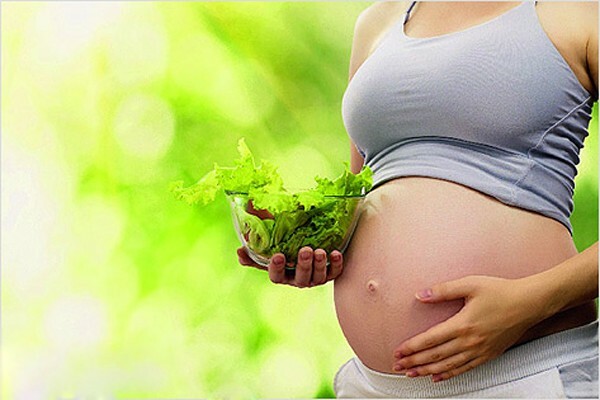
Attention. If a woman suffers from varicose or low blood pressure, which is very common during pregnancy, it is advisable to limit the use of mint.
The effect of a medicinal plant on lactation is especially interesting. In small doses, grass can increase the amount of milk, and in excessive doses, it can be reduced. Thus, if a woman wants to stop lactation, she should increase the intake of infusions and teas.
The healing properties and contraindications of peppermint have long been well studied. It is proved that this unique plant is able to fight many diseases and maintain female beauty for many years. Nevertheless, the reception of herbs for medicinal purposes is recommended to be coordinated with the doctor, since the plant has a number of contraindications.
Warning. The article is for informational purposes only. Consultation of a specialist is necessary.
